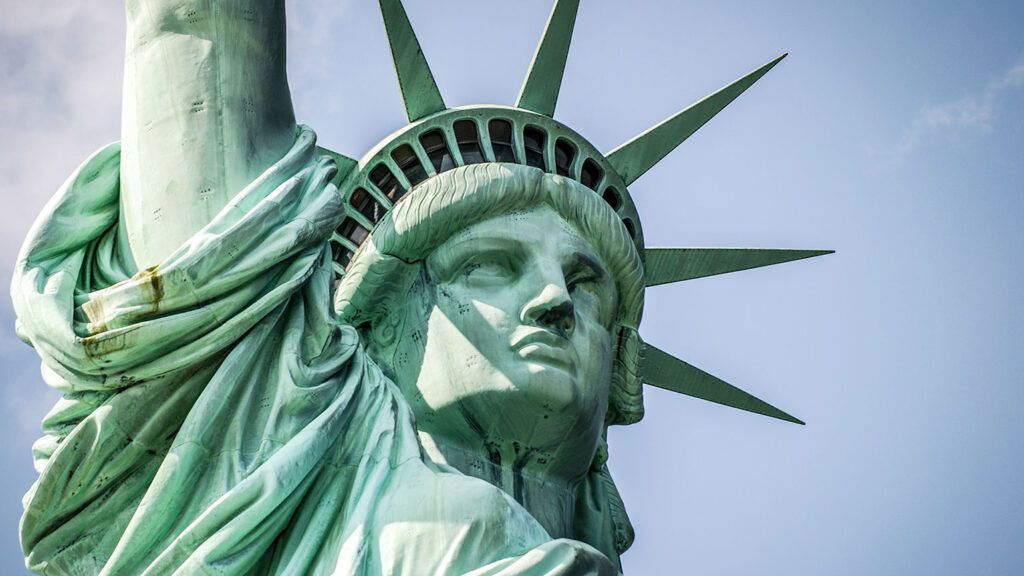Everyone knows about the big 100th birthday party planned for our renewed Statue of Liberty this July, but few know about the celebration held there four years ago when a man named Kenneth Lynch was honored for his unusual devotion to the Lady.
Who is Kenneth Lynch?
He is a highly respected metal craftsman in Wilton, Connecticut. His firm, Kenneth Lynch and Sons, Inc., is internationally known for its ornamental ironwork, sundials, balustrades, church grilles. Lynch and Sons fashioned the authentic-style armor for Cecil B. deMille’s film The Crusades, hammered out the giant stainless-steel eagles that glare from the shoulders of Manhattan’s Chrysler Building, and created the four huge Pegasus figures (winged horses) soaring over Reader’s Digest headquarters in Pleasantville, New York.
But why a “Kenneth Lynch Day” at the Statue of Liberty?
In 1928, when the Statue was 42 years old, some repairs were needed. Miss Liberty had borne the brunt of Atlantic gales; salt spray had pitted her copper exterior; and there had even been the time in 1916 when she had been hit by shrapnel from the explosion of the giant munitions plant a half-mile away on Jersey City’s Black Tom Island.
In those days the Statue came under the jurisdiction of the War Department, and so it happened that an Army lieutenant sought out the services of the 23-year-old Kenneth Lynch. This young man had worked his way around the world learning the fine art of his trade and now owned an ornamental metal shop in New York City.
A contract was signed and Lynch went to work. It was a difficult job; often he dangled in a bo’sun’s chair hundreds of feet in the air. Icy winds whipped at his hands as he restored rivets and sealed leaks. The most challenging task was that of replacing deteriorated copper plates, and this is where Lynch’s particular expertise came to the fore.
Lynch had mastered the art of repoussé, in which sheets of malleable metal are hammered into shape over hard molds. This is how the Statue had been constructed in Paris. Three hundred separate copper sheets, the thickness of a silver dollar, had been beaten and pressed into shape, then riveted together to form Lady Liberty’s exterior.
Kenneth Lynch worked with the special tools he’d brought from his workshop until the memorable day that he made an unexpected find. He was in the basement repairing the heavy iron strapping that anchors the Statue to its base, when he came upon some dusty wooden chests.
Curious, he opened them, and there inside were over 35 repoussé tools that had been used by the original Parisian builders. They had been shipped over in 1885 for use in reassembling the Statue in New York harbor.
Lynch was awestruck. Here were giant wooden mallets with two-foot-long rounded heads and five-foot handles used in shaping large sheets. There were several “Bibles,” hinged anvils on which to hammer sharp folds. Here were bench anvils, ball-shaped sledges, cross-pin hammers and metal pounding blocks looking like indented pillows. To a metalsmith they were a godsend and Lynch put them to work immediately.
When the job was completed—it took a year and a half but would have taken much longer without this happy find—Lynch returned the antique tools to their wooden chests in the Statue’s basement. But when presented with Lynch’s final bill for payment, the young lieutenant pointed to a clause in the work contract.
“This clearly stipulates that you are to leave the premises broom clean,” he said. “Now that means clean, free of any debris, equipment or tools!”
Lynch pointed out that the tools belonged to the Statue, that they were priceless historic artifacts.
The lieutenant was adamant. Either he removed the tools or Lynch would not be paid.
Reluctantly Lynch took the tools back to his shop and carefully stored them away. Resolved that their proper home was in the Statue of Liberty, he wrote a letter to the Secretary of War about the matter. The Secretary seemed disinterested. Lynch wrote letters to his congressman, the Smithsonian Institution, the Library of Congress.
No one seemed concerned about the return of the tools.
In the meantime Lynch went on with his own career, becoming widely known for his skill and artistry. Through the years, word of the historic artifacts in his possession spread. Collectors and antique dealers offered thousands of dollars for them, but Lynch refused every offer. The tools belonged to the American people.
Year after year, for over 50 years, Lynch wrote government authorities, even the President. When the Statue was turned over to the National Park Service, he wrote the island’s superintendent. Still nothing happened.
One night in 1981, as Lynch watched a TV news account of demonstrators at the Statue, he suddenly sat up straight. For on the screen, he noticed, was a new superintendent, David L. Moffitt, who was now in charge.
Immediately he sent Moffitt a letter.
Action at last! Of course the tools should come home! And within a few weeks Kenneth Lynch brought the tools back and placed them in the Statue’s museum, where they were seen by the American people for the first time.
In appreciation, David Moffitt saw to it that April 3, 1982, was “Kenneth Lynch Day.” Hundreds of people came to Liberty Island that Saturday to watch Lynch and his craftsmen in a special demonstration hammer out a large copper sheet representing a section of Lady Liberty’s gown, just as it had been done in France.
At the formal ceremonies that day, the invocation was given by the Reverend John G. Furniss, S.J., of New York City’s Xavier High School, which Lynch had attended as a boy.
In referring to Lady Liberty’s exterior, which is only three-32nds of an inch thick, Father Furniss said, “She is thin-skinned—sensitive—sensitive to the aspirations and hopes and rights of a free people. She is also strong,” he emphasized, “and it is these attributes we honor here today in Kenneth Lynch, extraordinary Christian and distinguished American, whose persistence and integrity have added a new dimension to this blessed symbol.”
For more inspiring stories, subscribe to Guideposts magazine.





